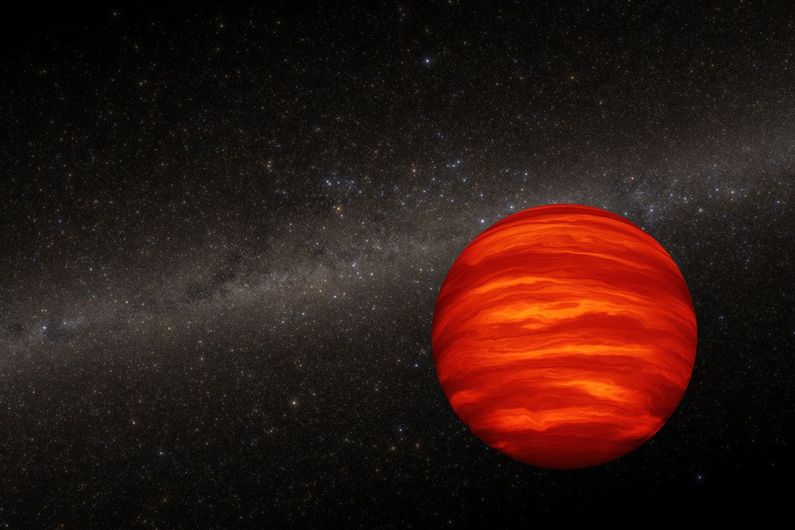UdeM astronomer finds that "brown dwarfs" grow old alone
- Salle de presse
03/21/2024
- UdeMNouvelles

This artist's concept shows a "brown dwarf," a space object more massive than a planet but smaller than a star. Brown dwarfs usually have binary companions, but as they age some of these binary systems gravitationally fall apart, and each brown dwarf goes its separate way, according to a study led by Université de Montréal astronomer Clémence Fontanive.
Credit: NASA, ESA, Joseph Olmsted (STScI)The interstellar objects are usually paired as binary systems, but in a new study Clémence Fontanive shows that, as they get older, few actually keep their companion.
Clémence Fontanive, a researcher at Université de Montréal's Trottier Institute for Research on Exoplanets, used NASA's Hubble Space Telescope to study some of the coldest and lowest-mass "brown dwarfs" of our solar system.
Brown dwarfs are interstellar objects more massive than Jupiter but less massive than the smallest stars. Like stars, brown dwarfs can be born in pairs and orbit around each other, in what is known as a binary system.
But in a paper published in The Monthly Notices of the Royal Astronomical Society, Fontanive and her research team report that no companions were found around 33 brown dwarfs observed with Hubble.
The fact that these relatively old brown dwarfs have no companions suggests that if some of them formed in pairs, they must have eventually parted ways.
"Our survey confirms that widely separated companions are extremely rare around the older, lower-mass brown dwarfs," said Fontanive. "Since binary brown dwarfs are observed at younger ages, this suggests that such systems do not survive over time."
Less massive, less paired
More than half the stars in our galaxy are found in binary systems, with the most massive stars usually accompanied by another star.
"There is a trend that the less massive an object is, the less likely it is to be found in a pair," said Fontanive. "The motivation for our study was to see if we continue to see this trend when we reach the very lowest-mass brown dwarfs."
The very low frequency of pairs deduced in the study reflects this trend, extending all the way down to the least massive objects. It also supports the theory that brown dwarfs are born the same way as stars, through the gravitational collapse of a cloud of molecular hydrogen.
The only difference: unlike stars, brown dwarfs do not have enough mass to sustain nuclear fusion of hydrogen for generating energy, Fontanive posited.
Formation processes are known to produce low-mass binary brown dwarfs; in 2020, Fontanive discovered just such a system in Ophiuchus, a young star-forming region. Her new study suggests these young binary systems are likely to get disrupted and will not survive to old age.
Why not? The most plausible explanation, said Fontanive, is this:
"When they're young, these pairs of brown dwarfs are part of a molecular cloud that disperses as it evolves. As that happens, things start to move and stars pass relatively close to each other. Because brown dwarfs are so light, the gravitational hold tying wide binary pairs is fragile, and bypassing stars can easily tear these binaries apart."
Hubble's search for companions
For their survey, Fontanive's team selected a sample of brown dwarfs previously identified by another NASA space telescope, the Wide-Field Infrared Survey Explorer. The sample consisted of 33 of the nearest and coldest rogue brown dwarfs, which had never been explored for binarity.
For these nearby objects, Hubble can detect binaries as close together as 500 million kilometres, the approximate distance between our sun and the "asteroid belt" region between the orbits of Jupiter and Mars.
These brown dwarfs are so cool (a few hundred degrees warmer than Jupiter in most cases) that their atmospheres contain water vapour that condensed out. To find the coolest companions, the astronomers used two different near-infrared filters: in one, cold brown dwarfs are bright; in the other, they appear very faint due to water absorption in their atmospheres.
“We could not have done this kind of survey without Hubble’s sharpness and sensitivity," said Fontanive. "It’s interesting but not surprising that we did not find anything. This confirms earlier models by providing the best observational evidence to date.”
About this study
"An HST survey of 33 T8 to Y1 brown dwarfs: NIR photometry and multiplicity of the coldest isolated objects," by Clémence Fontanive and seven co-authors in the U.S., France and Italy, was published Sept. 22, 2023 in Monthly Notices of the Royal Astronomical Society.
Media contact
-
Marie-Ève Naud
Institut Trottier de recherche sur les exoplanètes (iREx)
Tel: 514-279-3222 -
Jeff Heinrich
Université de Montréal
Tel: 514 343-7593












